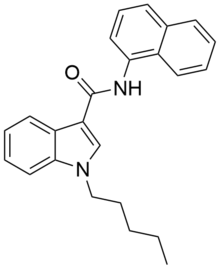NNE1
 | |
| Legal status | |
|---|---|
| Legal status |
|
| Identifiers | |
| |
| CAS Number | |
| PubChem CID | |
| ChemSpider | |
| CompTox Dashboard (EPA) | |
| Chemical and physical data | |
| Formula | C24H24N2O |
| Molar mass | 356.47 g/mol g·mol−1 |
| 3D model (JSmol) | |
| |
| |
NNE1 (also known as NNEI, MN-24 and AM-6527) is an indole-based synthetic cannabinoid, representing a molecular hybrid of APICA and JWH-018.[1] It was invented by Abbott and has a CB1 receptor pEC50 of 8.9 (i.e. EC50 of approximately 1nM) with around 80x selectivity over the related CB2 receptor.[2] It is suspected that metabolic hydrolysis of the amide group of NNE1 may release 1-naphthylamine, a known carcinogen, given the known metabolic liberation (and presence as an impurity) of amantadine in the related compound APINACA, and NNE1 was banned in New Zealand in 2012 as a temporary class drug to stop it being used as an ingredient in then-legal synthetic cannabis products.[3] NNE1 was subsequently found to be responsible for the death of a man in Japan in 2014.[4]
See also
References
- ^ Nahoko Uchiyama; et al. (October 2014). "Characterization of four new designer drugs, 5-chloro-NNEI, NNEI indazole analog, α-PHPP and α-POP, with 11 newly distributed designer drugs in illegal products". Forensic Science International. 243: 1–13. doi:10.1016/j.forsciint.2014.03.013. PMID 24769262.
- ^ Antoni R. Blaazer; et al. (October 2011). "Novel indole and azaindole (pyrrolopyridine) cannabinoid (CB) receptor agonists: Design, synthesis, structure–activity relationships, physicochemical properties and biological activity". European Journal of Medicinal Chemistry. 46 (10): 5086–5098. doi:10.1016/j.ejmech.2011.08.021. PMID 21885167.
- ^ New Zealand Government Gazette, Notice Number 7051, 1 November 2012
- ^ Chizuko Sasaki; et al. (January 2015). "A case of death caused by abuse of a synthetic cannabinoid N -1-naphthalenyl-1-pentyl-1H -indole-3-carboxamide". Forensic Toxicology. 33 (1): 165–169. doi:10.1007/s11419-014-0246-5.
